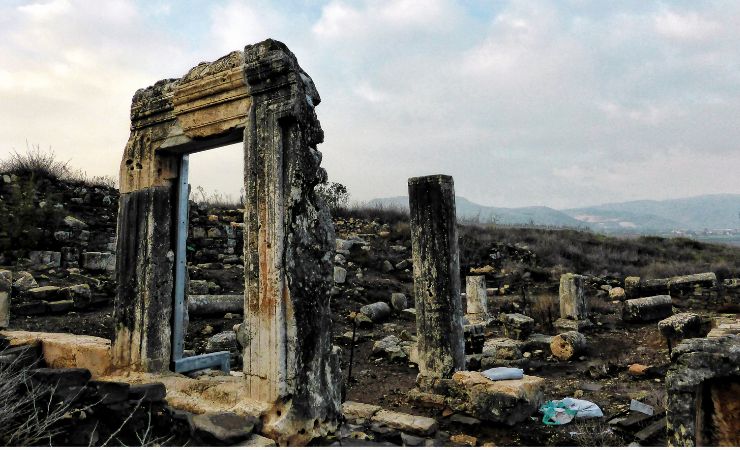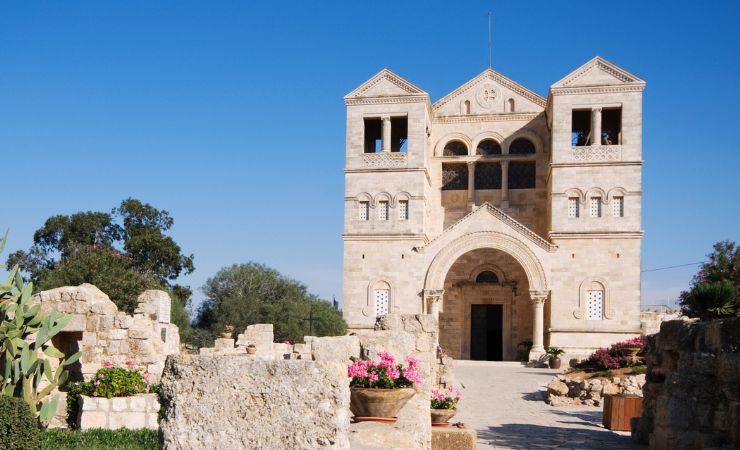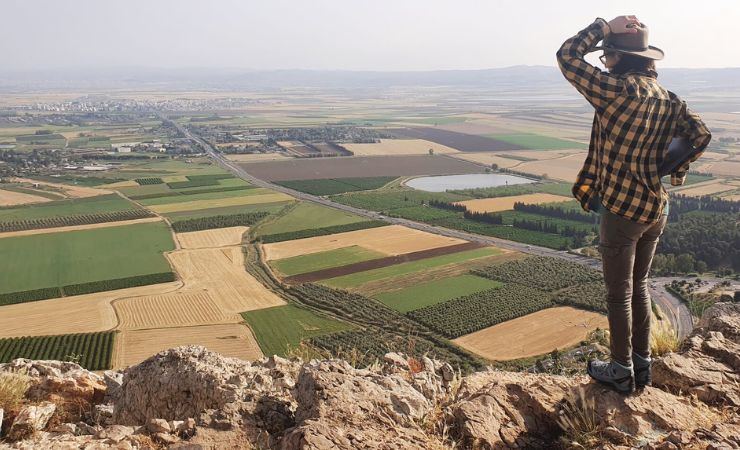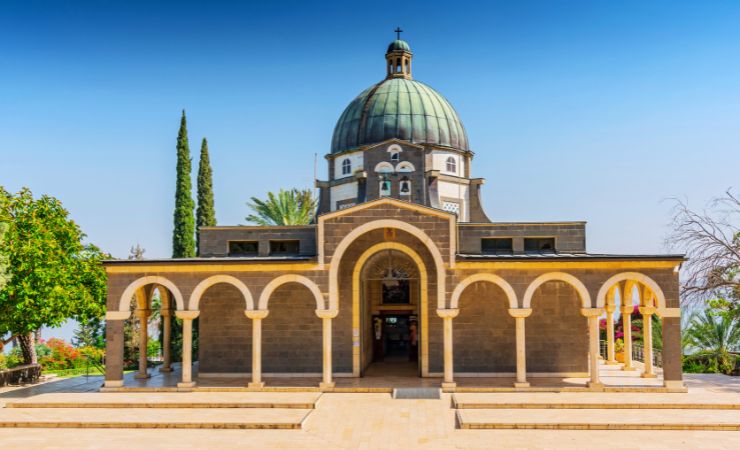The Arbel Synagogue Ruins: Where a Stunning Facade Still Stands
The discovery of ancient synagogues in the Galilee region of Israel has provided invaluable insights into Jewish life during the Roman and Byzantine periods. Among these significant finds is an ancient synagogue located below the cliffs of Arbel, a site steeped in history and natural beauty.

Location
The ancient synagogue of Arbel is located in the Lower Galilee, northern Israel. It’s perched near Mount Arbel, a dramatic bluff that rises above the Sea of Galilee, offering one of the most spectacular panoramic views in the country.
Biblical context
While the synagogue itself dates to later centuries, the area of Arbel may be connected to the “Beth-Arbel” mentioned in the Bible:



History of the Site
The region of Arbel has a long and storied past. It is mentioned as a place conquered during the Hasmonean period. According to tradition from that era, Arbel was the home of the sage Nitai.
The Roman-era historian Josephus Flavius identified Arbel as the site of a battle in 38 BCE between Herod the Great and Galilean rebels who had entrenched themselves in the area’s caves. Josephus also noted that he fortified the cave village of Arbel during the Great Revolt in 67 CE.
The synagogue itself dates from the Roman-Byzantine era. The synagogue at the Hamam Ruins was apparently founded in the Hasmonean period (first century BCE) and developed significantly during the Early Roman period. A large building, likely a synagogue from the end of the Second Temple period, was built in the first century CE, later replaced by a Galilean-style synagogue in the early third century CE. This later synagogue was rebuilt around 300 CE and eventually abandoned around 400 CE.
The Arbel Synagogue, distinct from the one at Hamam Ruins, dates from the 4th century CE and is believed to have been in continuous use until the 8th century CE. It was built in the center of the ancient Arbel village. The synagogue underwent at least two phases of construction. In its initial phase, the entrance was likely on the eastern facade, and the prayer direction was towards the west. In a later phase, the entrance was moved to the northern wall, and a niche for the Torah ark was constructed in the southern wall, aligning the prayer direction towards Jerusalem. This later configuration aligns with the layout of late-period synagogues where the entrance faced away from Jerusalem
Archaeological Findings
Excavations at the Arbel synagogue site (Irbid Ruins) have revealed a rectangular north-south hall with a large eastern courtyard. The main entrance, made of a single stone, was located on the eastern facade. The main hall was divided by three rows of columns into a nave and three aisles. Notably, two heart-shaped columns were found where the column rows met. The synagogue was a two-story structure, with Corinthian capitals on the first-story columns and Ionic capitals on the second-story gallery, which also featured Ionic half-columns attached to the inside walls. There was likely a Doric frieze on the upper part of the second story. The arrangement of benches was unique, with a wide platform along the east and west walls and additional benches in the aisles that also served as steps. In its later phase, a round niche for the Torah ark was added to the southern wall.
You’ll find today:
Architectural Style:
A basilica-style structure measuring about 20 by 18.5 meters. Built from limestone blocks, standing out against the basaltic landscape typical of the Galilee.
Columns and Capitals:
Three rows of columns, some still upright, with Corinthian and Ionic capitals. These would have supported a roof and created a stately, impressive interior.
Seating Arrangements:
Stone benches along three walls where congregants once sat during services.
Torah Niche:
In the southern wall, a niche designed to house the Torah Ark, elevated by a small platform (bema) in front.
Entrances:
Originally, the main entrance was on the eastern wall, facing Jerusalem. Later, a new entrance was added to the northern side.
Additional Information
- 1st Century BCE (Around 40 BCE): Herod is appointed by the Romans to rule over Judea. The inhabitants of the Galilee, including those of Arbel, oppose his rule and revolt, inflicting heavy losses on his army.
- 38 BCE: Herod returns to fight the rebels who have taken refuge in the caves of Arbel. He uses specialized boxes with hooks to drag them out and throws them into the ravine. Some choose suicide over surrender.
- 1st Century CE (Around 68 CE): During the Great Revolt against the Romans, Josephus Flavius, the commander of the Galilee, fortifies Arbel due to its strategic location at a crossroads.
- Post-Second Temple Destruction (70 CE onwards): A family of priests from the order of Yeshua (the ninth priestly division that served in the Temple) settles in Arbel. They become known as the “Kohanei Arbel” (Priests of Arbel).
- Roman and Byzantine Periods (roughly 2nd-6th Centuries CE): Arbel flourishes as a Jewish settlement.
- Archaeological evidence suggests the main synagogue at Arbel was constructed sometime between the 2nd and 4th centuries CE, with potential later Byzantine period modifications. Some scholars argue for a primarily Byzantine construction date (5th-6th centuries).
- Arbel becomes known for its production of strong flax textiles, in contrast to Bet She’an’s delicate flax production.
- The town’s high-quality wheat is also praised in the Jerusalem Talmud.
- The Jerusalem Talmud records a story involving Rabbi Hiyya Rabba and Rabbi Shimon ben Halafta walking in the Arbel Valley at dawn, using the breaking light as a metaphor for the gradual redemption of Israel.
- A 4th-century CE inscription in the Hamat Gader synagogue mentions contributions from the people of Arbel, indicating their connection to other Jewish communities.
- Archaeological excavations in 2000 reveal structures and two ritual baths (mikva’ot) from the Roman and Byzantine periods west of the main synagogue.
- In 2007, another synagogue is discovered about a kilometer north at Khirbet Wadi Hamam.
- Medieval Period:Medieval travelers, both Jewish and Muslim, identify Irbid Ruins (on the northern outskirts of modern Moshav Arbel) as the location of ancient Arbel.
- 19th Century (1875): The Survey of Western Palestine expedition of the Palestine Exploration Fund, including Claude Conder, surveys the site of Arbel. Conder identifies it as an important archaeological site and sketches the plan of the synagogue.
- Early 20th Century (1905): A German expedition led by Heinrich Kohl and Carl Watzinger further investigates the synagogue, dating it based on decorations to the 2nd-3rd centuries CE and producing a plan of the structure.
- 1960s: Nahman Avigad examines the niche in the synagogue and dates it to a later Byzantine period as a Torah Ark niche.
- 2000: Arbel is added to UNESCO’s Tentative List for World Heritage Travellers. Excavations west of the synagogue uncover more structures and mikva’ot.
- 2021: A 5-ton monolithic column from the 3rd-4th century CE synagogue is reinstalled after conservation work. Excavations under its base reveal about 140 Roman and Byzantine coins, indicating two construction phases. A new accessible wooden deck leading into the synagogue is also constructed, funded in part by the family of Max Steinberg, a lone soldier killed in action.
Nearby Sites
- Mount Arbel National Park: A dramatic cliffside hikes and be rewarded with sweeping views across the Sea of Galilee.
- Magdala: An ancient first-century synagogue and a beautiful Duc in Altum prayer center.
- Horns of Hattin: A historic hilltop famous for the 1187 battle between Crusaders and Saladin.
Capernaum (Kfar Nachum):
An ancient fishing village where Jesus taught in the synagogue.Capernaum (Kfar Nachum):
An ancient fishing village where Jesus taught in the synagogue; the ruins include a 4th-century synagogue built on top of a 1st-century one.



